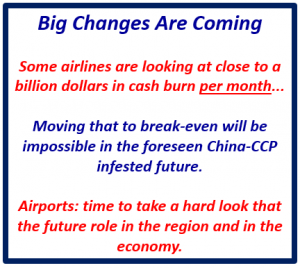Air Service 2021:
Let’s Wake Up & Smell The Cash Burn
Last summer, it appeared that the air transportation industry was rebounding strongly.
June, July and August indicated a traffic trajectory that pointed toward 80% or more of 2019 enplanements by the end of the year.
Alas, the airline industry was ready… the China/CCP pandemic made sure that the economy and the marketplace were not.
American Airlines just advised that it will be burning $30 million in cash daily through the end of December. That is almost one billion dollars a month. Much smaller JetBlue has indicated an $8 million daily cash burn.
 While American and other U.S. carriers are for the moment apparently well set in regard to financial reserves, it does not take a Doctorate from Wharton to figure out that this situation is not sustainable – and will need to change very, very soon.
While American and other U.S. carriers are for the moment apparently well set in regard to financial reserves, it does not take a Doctorate from Wharton to figure out that this situation is not sustainable – and will need to change very, very soon.
One of two outcomes: Either the traffic and revenue base returns to a level that can support the current airline structure, or the airline structure will need to adjust.
Let’s stop the fantasy and skyhook-like wishful thinking. Based on the willy-nilly, almost panicked run-here, run-there responses from governors across the nation, none of which seem to do much except destroy business and commerce, it is at this moment obvious that it’s the second alternative that will be imperative. People cannot travel freely.
Airlines in the first quarter of 2021 will need to completely re-structure to fit the new economic environment. Yup, carriers might have big cash hoards, but they are largely based on loans, and every dollar they spend now will need to be repaid, and repaid within a much smaller set of revenue streams.
Of course, another (necessary) federal support mechanism for the airline industry is critical, but it is clear now that there is no returning to the pre-China-CCP pandemic system we had in the past. Airlines will need time to not just shrink the scope of their route systems, but to adjust fleets and staffing accordingly.
The unfortunate part of this is that almost any such relief coming from inside the Marble Playpen, a.k.a. congress, will be accessorized by cheap political garbage, such as demanding that airlines continue to fly to places that don’t generate enough traffic to fill a VW Microbus.
In The Post China-CCP Pandemic Word, The House (The Economy) Has The Odds. Just like the occasional “777” that comes up on casino slot machines, the recent moves by some carriers to enter new domestic and international routes should not be misunderstood. These are actually part of the eventual major restructuring of the air transportation system, and not an indication that happy days are just around the corner.
 Southwest is aggressively looking at new revenue streams from airports that one year ago it would have not even considered. But, missed in some of the veneer articles such as those trumpeting how much “damage” they supposedly can do to United and American at ORD (group think, nothing more), the fact is that the airline has stated it will not be expanding its fleet. In other words, Southwest is adjusting their system to meet the crisis, not growing the network, per se.
Southwest is aggressively looking at new revenue streams from airports that one year ago it would have not even considered. But, missed in some of the veneer articles such as those trumpeting how much “damage” they supposedly can do to United and American at ORD (group think, nothing more), the fact is that the airline has stated it will not be expanding its fleet. In other words, Southwest is adjusting their system to meet the crisis, not growing the network, per se.
United is adding some additional new international routes. But it, too, has been clear that overall system capacity growth isn’t in the near-term plan. Again, as the two United vice presidents pointed out at the International Aviation Forecast Summit in October, the airline is actively moving resources to accommodate the shrinkage of the national and international marketplace.
The hard reality is that air transportation economics in the post China pandemic world will have a very different role. Airline hub operations are much smaller than one year ago, and that means the entire feed systems will change.
Airports such as Worcester, New Haven, and others have lost the low levels of schedule access they had before the pandemic. Take a look at the load factors, and it is no wonder that in a shrinking air transportation system, they are toast. In these specific cases, the communities are not “without air service” – ORH still has Boston and HVN has Hartford/Springfield – where most of the demand was going, anyway.
We can go on, but there’s a lot of project work on the table here at BGI. The hard point is that every airport in America needs to now – right now – take a look at its current air service access, and make hard contingency decisions in the context of the 2021 airline system.
Doing more 30K “true market studies” is a great temporary placebo to divert energies from facing the new realities… the data that is on the books is from an air transportation system that no longer exists.
There are some opportunities inside this dark cloud… as carriers move to consolidate and redeploy resources, there are a number of airports that are in the cross-hairs of some strong traffic growth.
But one thing is certain: The airline industry will be undergoing very substantial strategic and market changes in the first half of 2021. Airports that assume a rebound is coming will be caught blind-sided.
 If your community is interested in crafting a plan that addresses the uncertainties of the future, give us a call. We are delivering our Runway To The Future™ program to a number of our clients. Unlike other consultants, Boyd Group International is the leader in aviation traffic and trend forecasting, and we can assist in developing a battle plan to optimize the new future.
If your community is interested in crafting a plan that addresses the uncertainties of the future, give us a call. We are delivering our Runway To The Future™ program to a number of our clients. Unlike other consultants, Boyd Group International is the leader in aviation traffic and trend forecasting, and we can assist in developing a battle plan to optimize the new future.
Unlike other consultants, we focus on the future dynamics that will drive air traffic – not stale data from yesterday.
Click here for more details, and then drop us an email to set up a time to talk… ten minutes can make a difference.
One thing is certain… the air transportation system we see today cannot exist too much longer.
_______
FROM ALL OF US AT BOYD GROUP INTERNATIONAL, HAVE A GREAT AND HEALTHY WEEK AHEAD!